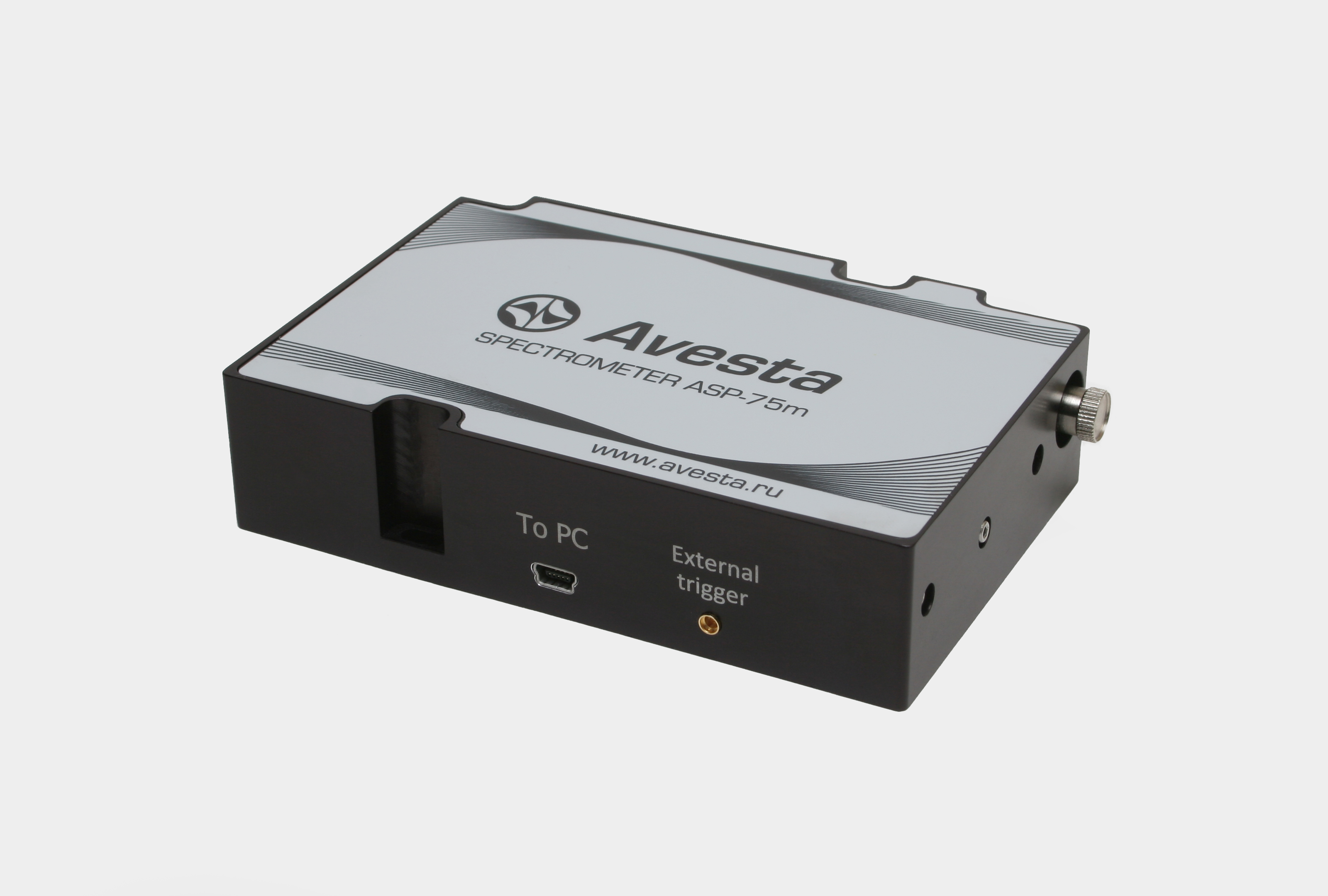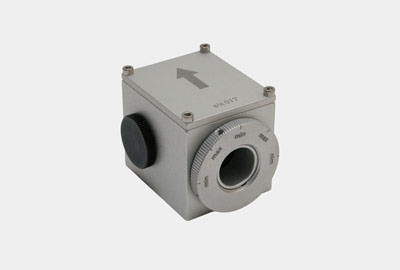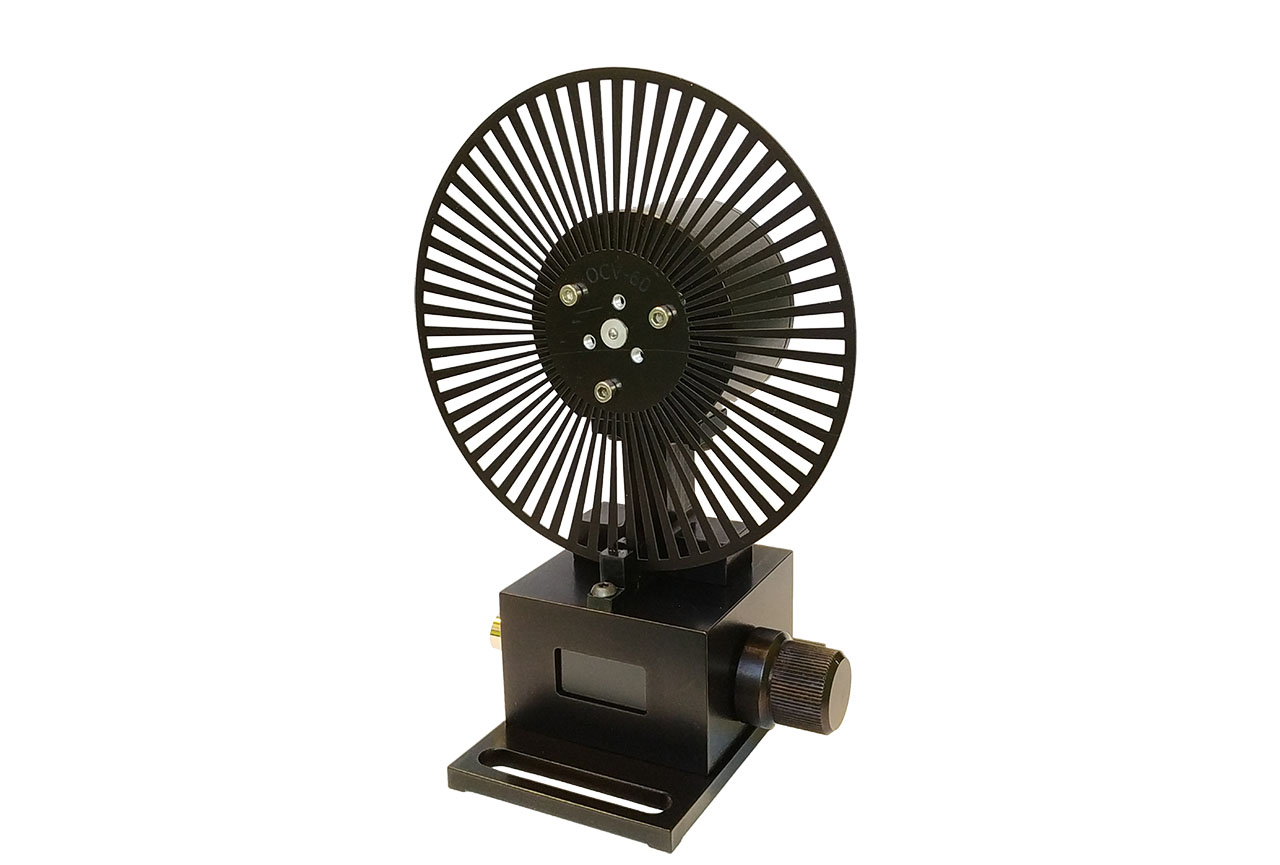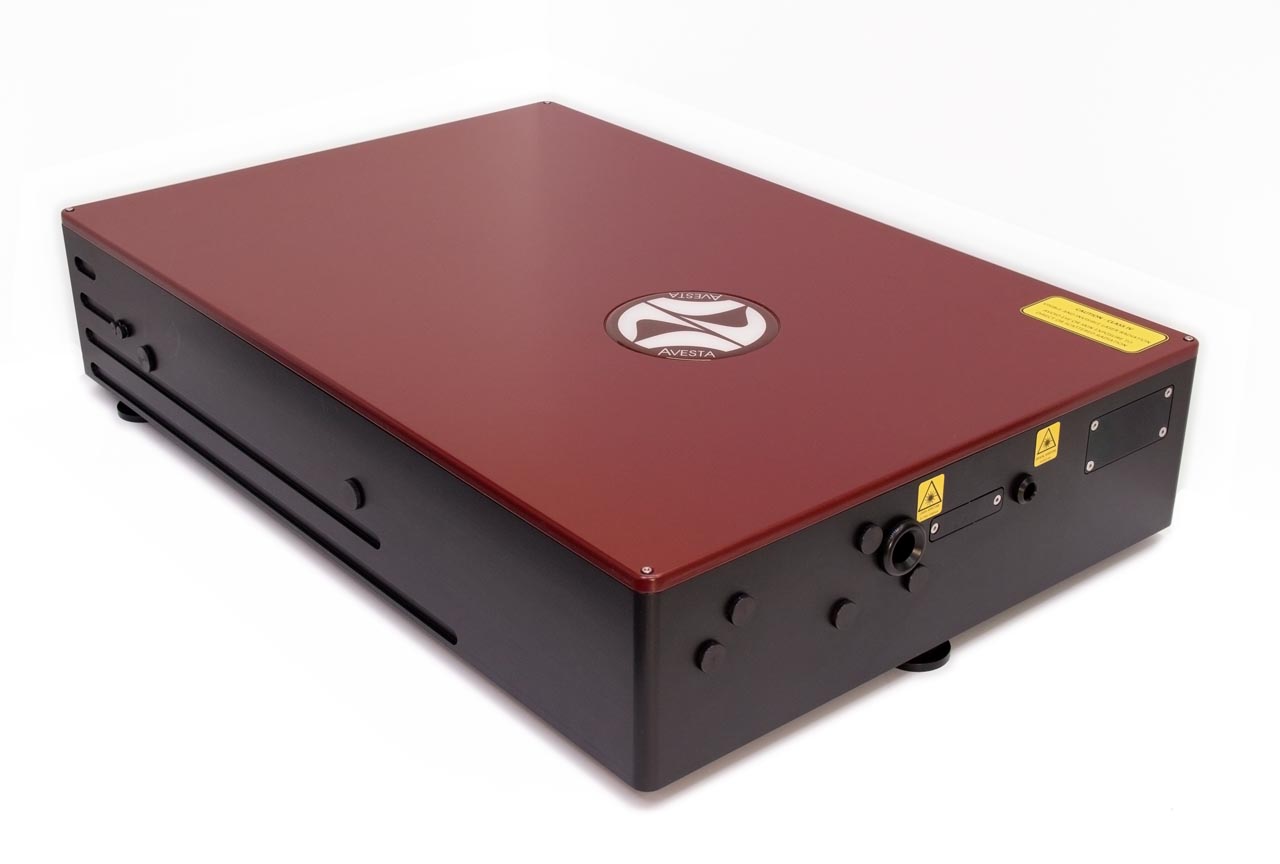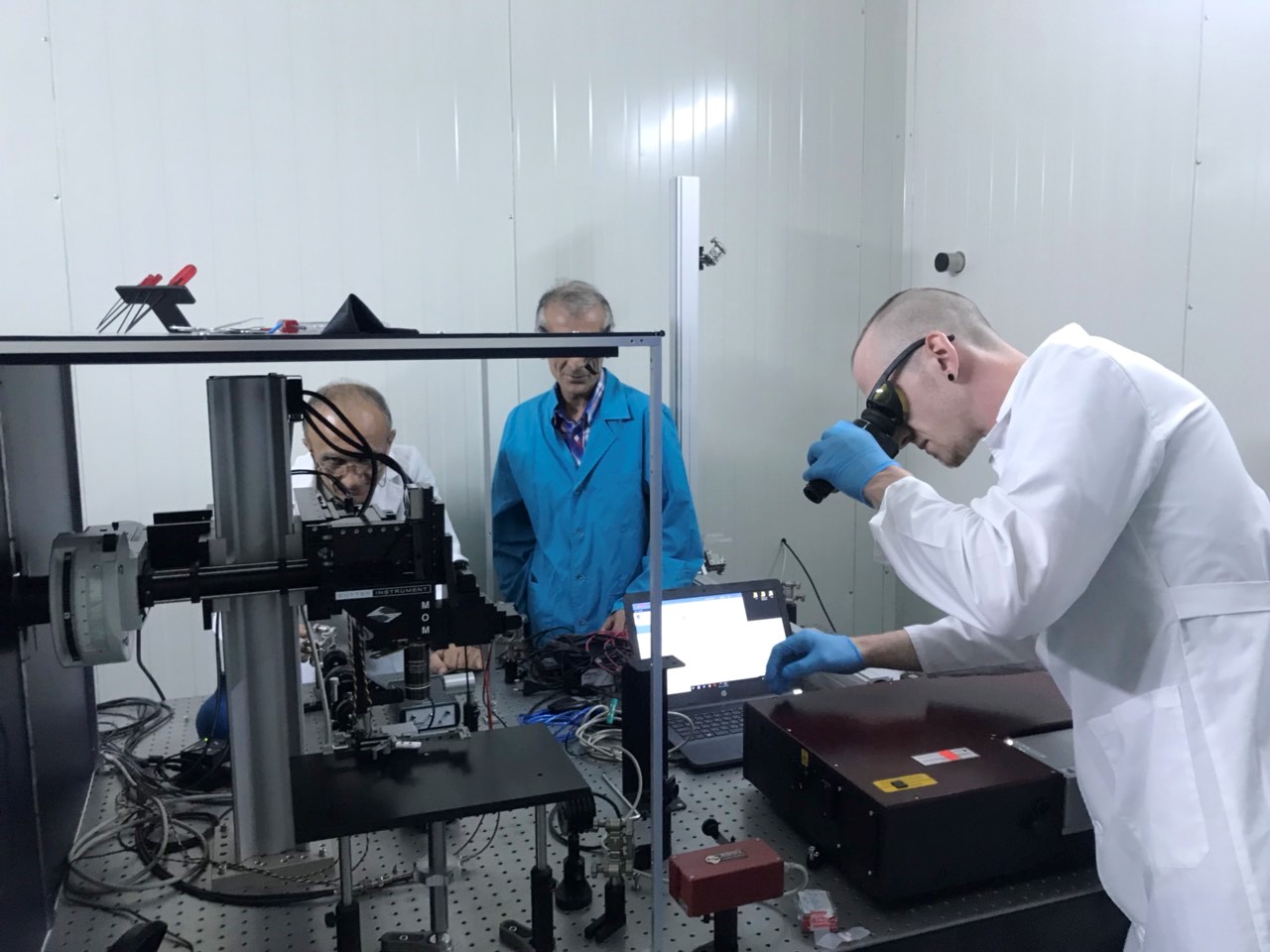ASP-150. Multipurpose Spectrometer
| Optical specifications | ||||||||
| Optical scheme | Czerny-Turner | |||||||
| Spectral range for choosing the registration domain*, nm | 190-1100 | 190-800 | 190-450 | 190-300 | ||||
| Grating(1), grooves/mm |
200 | 300 | 400 | 600 | 1200 | 1800 | 1800 II order |
1800 III order |
| Registration domain width*(1), nm | 950 | 640 | 480 | 315 | 145 | 90 | 40 | 25 |
| Spectral resolution*, nm | 0.6 | 0.42 | 0.3 | 0.2 | 0.09 | 0.06 | 0.025 | 0.017 |
| Dispersion, nm/mm | 33.2 | 22.4 | 16.8 | 11.0 | 5.1 | 3.1 | 1.4 | 0.9 |
| Input slit | 10 µm | |||||||
| Focal length | 150 mm | |||||||
| Focal length of the camera objective | 150 mm | |||||||
| Relative aperture | 1:13 | |||||||
| Input type(2) | free-space and SMA905 fiber socket (FC socket or fiber patch-cord on request) | |||||||
| Synchronization | external/internal | |||||||
| PC connection | USB | |||||||
| Dimensions (LxWxH) | 242х115х76 mm (ASP-150T); 205х115х76 mm (ASP-150C) | |||||||
| Weight | 1.6 kg | |||||||
| CCD array specifications (any array can be combined with any grating type) | ||||||||
| Model | Toshiba 1205DG | Toshiba 1304DG | Hamamatsu S8378-1024Q |
|||||
| Number of pixels | 2048 | 3648 | 1024 | |||||
| Pixel width | 14 µm | 8 µm | 25 µm | |||||
| Pixel height | 200 µm | 200 µm | 500 µm | |||||
| Minimum exposure time | 4.2 ms | 7.3 ms | 2.1 ms | |||||
| Maximum exposure time | 4 s | 5 s | 5 s | |||||
| Sensitivity(3), photons/count | 80 | 20 | 650(3000)(4) | |||||
| Antiblooming(5) | yes | no | yes | |||||
| Meansquare noise of reading, counts of ADC | 5.4 | 3.5 | 16(4.4)(4 | |||||
| ADC | 14 bit, 16384 counts |
14 bit, 16384 counts |
14 bit, 16384 counts |
|||||
| Dynamic range | 1000:1 | 1000:1 | 1000:1 (4000:1)(4) | |||||
| (1) - the necessary grating type, and hence the width and the central wavelength of the instantaneously registered range (aka registration window) inside the full possible range of the CCD detector should be specified when sending the request. The ASP-150C model has the chosen grating and its position fixed at factory, while the ASP-150T model has the possibility to adjust the position of the registration window via microscrew rotation, thus covering full possible range with the highest resolution; (2) - each spectrometer is equipped with a fiber socket and allows measurement of either free-space or fiber signals without any realignment; (3) - sensitivity given at the wavelength of 550 nm; (4) - the Hamamatsu arrays provide for sensitivity control via special driving signal, that can set either low (values in brackets) or high sensitivity mode; (5) - the property of the CCD to prevent the charge flow from the neighboring overexposed pixels; * - values given for the Toshiba 1304DG CCD array. |
||||||||
The ASP-150C spectrometer is an ideal choice for a wide variety of different optical applications with its flexible tuning and high resolution. There is always a place for the ASP-150C on the optical table due to its small size, functionality and friendly interface.
The ASP-150T model is able to carry out measurements in a wider spectral range without any losses in resolution, owing to a special tunable mechanism.
All models have a special fiber input with a spectral slit, the size of which is conditioned with the detector. It allows measurement of either free-space or fiber signals without any realignment. However, it is not recommended to use fiber to measure spectrum of a femtosecond laser due to signal modulation and subsequent spectrum distortion.
Q: What are the spectral range for choosing the registration domain and the registration domain width? How are they determined and interrelated?
A: The customer must choose two things when ordering the ASP-75/ASP-150 series spectrometer unit: the diffraction grating density and the CCD detector model. While the detector choice mainly affects such parameters as integration time, noise and sensitivity, the grating density determines the exact values for the two main spectral ranges in consideration:
The spectral range for choosing the registration domain is the complete available spectral range that is determined by the detector type and in some cases by the spectrometer design limitations. A Si-based linear CCD detector in case of the ASP-75/ASP-150 series is typically specified to have 190-1100 nm full spectral range. However, this range is decreased in the longer wavelength region when the customer chooses the 1800 lpmm grating or its higher orders due to grating angles limitations in the spectrometer geometry.
The registration domain width is the current registration window width (i.e. the actual width in nm of a single CCD acquisition event for a particular spectrometer configuration, also known as simultaneous detection range). It is the actual spectral measurement range you can get from a particular spectrometer model with a fixed grating (ASP-75, ASP-150C) or from a tunable grating spectrometer (ASP-150T) without tuning the grating. The width of this registration domain (aka registration window) is determined by the diffraction grating groove density. The denser is the grating, the narrower the registration domain becomes. For a fixed grating model the exact range of choice has to be set at factory. For a tunable model the user has the ability to tune the registration window over the whole accessible spectral range for a certain grating type.
Practical hints:
- if you need to study the spectra in the whole 190-1100 nm range (be it tunable, stitching, simultaneous or a certain smaller range inside), you must limit your choice to the 1200 lpmm grating or sparser, 1800 lpmm grating or its higher orders has limited range in the longer wavelengths;
- if you need to measure full range 190-1100 nm in a single CCD acquisition (i.e. simultaneously, without grating tuning or stitching), the only grating that is suitable for this task is the 400 lpmm in case of ASP-75 or the 200 lpmm grating in case of ASP-150C/ASP-150T. All other gratings would require to narrow down the registration range in case of fixed grating models (ASP-75/ASP-150C) or tune the grating in case of the tunable grating model (the ASP-150T). I.e. all other gratings have smaller single CCD acquisition domain width, so either a certain smaller range for measurement has to be determined at order inside the overall available detection range, or a tunable spectrometer system may be purchased (the ASP-150T);
- you can choose denser gratings to increase the resolution, but the simultaneous CCD detection window width will inevitably get narrower. Thus you would need to sacrifice the spectral width for resolution and vice versa.
E.g., with the ASP-150C model, the resolution of 0.09 nm corresponds to the 1200 lpmm grating. The spectrometer will then have effective spectral range width of 145 nm, and not full 190-1100 nm. The customer must choose where this range should be, but it is selected at our factory and cannot be changed later (145-wide area of the possible range, i.e. 350-495 nm or 855-1000 nm etc.). It is like a “window” and you choose the width of this window by selecting the grating type (which affects resolution), and its position in respect to the whole registration range. So the wider the window, the lower the resolution. Thus, in order to cover full range of 190-1100 nm at once the grating should be 200 lpmm (providing wide enough window to cover the 190-1100 nm spectral range of the CCD) but the resolution will be ~0.6 nm.
Same principle applies for the ASP-75, but it generally has lower resolution values due to shorter focal distance.
As for the ASP-150T model, it has customer-tunable registration domain (window), this domain can be tuned by the customer and moved over the whole registration range to have better resolution (this is realized via grating tuning by manually controlled micrometer). In our example above with the 1200 lpmm grating with the ASP-150T you can move the "window" via micrometer screw and move the 145-nm region over the whole 190-1100 nm range, and have 0.09 nm resolution. Note that for all units for denser gratings and higher orders of gratings, the full spectral range gets narrower due to design limitations. That is why we have to indicate all this in our spec sheet.
Related products
Latest News
Ti:S oscillator with up to 3 W output power at 100 fs
We have ramped up the maximum available output power for the TiF-100 series to more than 3 Watts at 800 nm, 100 fs, 80 MHz. The tuning range has also been extended to 720-950 nm, while an optional modification that covers 850-1040 nm is also available. The system features a high-power low-noise integrated DPSS laser […]
TiF-100ST-F6 femtosecond Ti:S oscillator with Frep locking for multiphoton microscopy at CANDLE, Armenia
The TiF-100ST-F6 femtosecond Ti:S oscillator with a built-in pump laser, also equipped with the ALock PLL electronics unit for pulse repetition rate locking to an external RF source has been installed at the Synchrotron Research Institute’s CANDLE facility in Armenia. The setup has been developed and commercialized during the joint Russia-Armenia project supported by FASIE (Innovation […]




